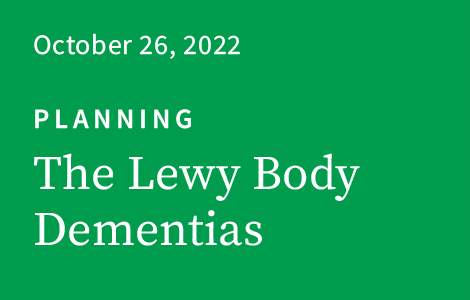Transcript
Lewy Body Dementias
The Lewy body dementias are the second most common neurodegenerative dementia after Alzheimer’s, affecting some 1.4 million Americans, yet few of us have heard of them. Two clinically distinct but related diseases comprise the Lewy body dementias: dementia with Lewy bodies, also known as DLB, and Parkinson’s dementia. The hallmark neuropathology of these diseases is the Lewy body, a protein aggregate that accumulates in specific brain cells. We’ll first focus on dementia with Lewy bodies, DLB, and then turn to Parkinson’s dementia.
In DLB, cognitive impairment develops together with other, characteristic problems. The first of these is motor changes suggestive of parkinsonism. Movements slow and grow more effortful. Gait slows and starts to shuffle. Posture degrades, and balance may deteriorate. A tremor can develop. Facial expression and speech volume may diminish, too. These changes can lead to a misdiagnosis of Parkinson’s or related diseases.
Visual hallucinations are the second clinical feature. These often arise early in the course of disease, and are usually nonthreatening. Most often, people see hallucinations of people or animals, which are not accompanied by sound.
The third characteristic feature of DLB is REM sleep behavioral disorder, a phenomenon in which people can act out their dreams. REM sleep is a dream-rich state in which our bodies are normally paralyzed while our eyes are free to move. In REM sleep behavioral disorder, the normal paralysis of REM sleep is diminished. As a result, patients may punch, kick, or even fall out of bed, potentially injuring themselves or their bed partner.
The fourth clinical feature of DLB is fluctuating cognition, with profound variation in clarity of thought or level of alertness. People can stare off into space at times or be intermittently tangential in conversation. Marked but episodic daytime sleepiness can develop, despite a good night’s sleep.
Together with progressive dementia, these characteristic features comprise the core clinical presentation of DLB. While they tend to co-occur, not all patients with DLB will have all four.
In DLB, the thinking problems that develop can mimic Alzheimer’s, with early and progressive short-term memory loss. More often, however, additional domains of thinking tend to be involved from the beginning. Many patients experience early problems with executive function, with resulting difficulties in planning and organization that can impact their ability to manage the household finances or use a smart phone, for example, and to multitask. Some patients develop early problems with visual-spatial function. As a result, sense of direction may degrade.
Interestingly, there is significant overlap in the clinical features of DLB and Parkinson’s dementia. In Parkinson’s, patients develop these same motor changes—but in the absence of significant cognitive impairment. As Parkinson’s progresses, however, the risk of developing cognitive impairment accrues. As a result, dementia is common in Parkinson’s, affecting some 30 to 80 percent of patients living with the disease.
DLB and Parkinson’s dementia share other clinical features as well. In both, REM sleep behavioral disorder and visual hallucinations are common. In both, memory loss, executive dysfunction, and visuospatial impairments are frequent.
The key differentiating feature between DLB and Parkinson’s dementia is the timing of dementia relative to motor problems. When cognitive problems start prior to or within one year of Parkinsonian motor changes, a diagnosis of DLB is made. Otherwise, a diagnosis of Parkinson’s dementia is made. However, this one-year rule is arbitrary. Together with the shared hallmark neuropathology, the Lewy body, the clinical overlap between DLB and Parkinson’s dementia supports the idea that these illnesses reflect a clinical spectrum of the same disease.
There is currently no cure for the Lewy body dementias. Even so, making the diagnosis matters: Several treatment strategies exist that can help Lewy body dementia patients, improving both function and quality of life; additionally, certain medication classes can be dangerous in the Lewy body dementias and must be avoided.
Given the need for clinical expertise, patients and their loved ones may want to access tertiary care centers for diagnosis and management of the Lewy body dementias. The diagnostic evaluation includes a careful history including a review of medication exposures, a neurological exam, blood testing (to identify reversible contributions to cognitive impairment), and brain imaging. There is as yet no FDA-approved test that can make the diagnosis. However, several studies can be helpful, such as dopamine transporter imaging or a sleep study.
Clinical expertise is also needed for the management of the Lewy body dementias. The clinical features of these diseases can respond both to pharmacologic and nonpharmacologic strategies, and it is important for physicians to work systematically to optimize treatment.
For example, cognitive impairment can respond to drugs known as an acetylcholinesterase inhibitors that increase brain acetylcholine levels. The brain cells that make acetylcholine play an important role in thinking and are universally impacted in the Lewy body dementias. These same drugs are used to treat Alzheimer’s but tend to be more effective in the Lewy body dementias. Every patient deserves an optimized trial of this drug class.
Conversely, several medications can exacerbate thinking problems in these diseases. Thus, a careful review of medications is vital. This is also true for Parkinson’s medications, as many can cause or exacerbate cognitive impairment or hallucinations. These can be substituted as needed.
Hallucinations often respond to nonpharmaceutical strategies, such as closing the blinds before dusk, keeping the home well lit, and verbal redirection. In addition, acetylcholinesterase inhibitors can help. If hallucinations grow pervasive or threatening, there are other medications to consider, including some antipsychotics, but these need to be selected and used with caution and expertise. While some can be effective, all antipsychotics come with risks. In fact, antipsychotics with strong activity against the dopamine D2 receptor—such as haloperidol—are extremely dangerous in the Lewy body dementias. They significantly increase the risk of death and need to be avoided.
With respect to treating the motor manifestations of parkinsonism, physical therapy plays an important role, as do medications that target the brain dopamine system. Such medications—like carbidopa/levodopa—can be very helpful in some patients, but they also require careful selection and dosing to avoid worsening cognitive impairment or hallucinations.
Exercise is another important treatment strategy. Exercise can help with both thinking and motor function and is an invaluable tool in the armamentarium.
In managing REM sleep behavioral disorder, one key step is to remove sharp objects such as nightstands from the sleep environment. Melatonin is helpful in some patients. Doctors can consider other classes of medicine as well.
Because the Lewy body dementias are complex diseases that affect cognitive, physical, and behavioral function, patients benefit from a care team. In addition to the treating neurologist, physical therapists help with motor function and fall prevention, occupational therapists optimize home safety and activities of daily living, speech therapists treat speech and swallowing, and social workers support patients and their caregivers, guiding discussions around optimizing home care and helping with possible transitions to long-term care facilities.
I’ll leave you with one thought. The shared brain changes of DLB and Parkinson’s dementia together with their overlapping clinical features not only support the concept of a clinical spectrum of disease: More than this, they raise the possibility that a cure for one of these Lewy body dementias will be a cure for both.
Stephen Gomperts, MD, PhD
Director, Lewy Body Dementia Unit, LBDA Research Center of Excellence
MassGeneral Institute for Neurodegenerative Disease
Department of Neurology
Massachusetts General Hospital

